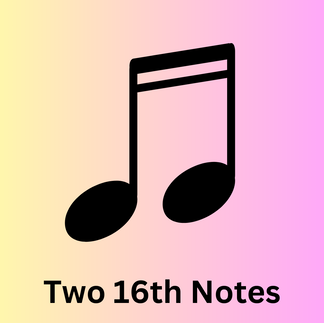Mastering Sixteenth Notes
- Preslea Kintzle

- Sep 14, 2023
- 2 min read
Updated: Sep 27, 2023

Sixteenth notes, also known as semiquavers, are a fundamental rhythmic element in music. They add a level of intricacy and energy to music, making it more exciting and dynamic. Whether you're a beginner looking to understand the basics or an experienced musician aiming to perfect your rhythm, mastering sixteenth notes is essential. In this comprehensive guide, we will explore everything you need to know about sixteenth notes, from their notation and counting to practical exercises that will help you incorporate them into your playing seamlessly.
Understanding Sixteenth Notes
Before diving into mastering sixteenth notes, it's crucial to understand what they are. Sixteenth notes are a type of musical note that divides a single beat into four equal parts. In most time signatures, they are typically represented as small flags attached to the stems of the notes, with four flags denoting a sixteenth note.
Counting Sixteenth Notes
To master sixteenth notes, you must be able to count and feel their rhythmic subdivision accurately. The most common method is to count them as "1 e and a 2 e and a" for each beat in 4/4 time. Here's a breakdown:

"1" corresponds to the downbeat.
"e" is the first sixteenth note subdivision.
"and" is the second sixteenth note subdivision.
"a" is the third sixteenth note subdivision.
Practice counting these subdivisions aloud while tapping your foot to develop a strong sense of their timing.
If you are a person who struggles with counting, you can think of word replacements too. For sixteenths (this word will help you later on, especially if you are a woodwind player), think of the word "kitty".
Notation and Symbols
Understanding how sixteenth notes are notated is crucial for reading and interpreting music. As mentioned earlier, they are represented with flags attached to note stems. When sixteenth notes are grouped together, they may be connected with beams, making it easier to read.

Additionally, sixteenth rests, represented by a small squiggle-like symbol, indicate silence for one sixteenth note duration.
Practical Exercises To Mastering Sixteenth Notes
Clapping and Counting: Start with simple rhythmic patterns and clap them while counting "1 e and a 2 e and a." Gradually increase the complexity of these patterns to improve your timing.
Metronome Practice: Use a metronome to set a tempo and practice playing or clapping sixteenth notes along with it. This will help you develop a steady sense of timing.
Rhythmic Etudes: Explore pieces of music or etudes specifically designed to improve your sixteenth note skills. Famous composers like Bach and Chopin have written works with intricate sixteenth note passages.
Subdivision Drills: Practice subdividing beats into sixteenth notes by dividing them into various combinations. For example, try counting "1 e" and "and a" repeatedly to internalize the different subdivisions.
Playing with Dynamics: Experiment with playing sixteenth notes at different dynamic levels (soft, loud, crescendo, decrescendo) to add expressiveness to your music.
Mastering sixteenth notes is a fundamental skill for any musician. It enhances your ability to play complex rhythms, making your music more dynamic and exciting. By understanding the notation, counting accurately, and practicing with dedication, you can elevate your musical abilities and confidently tackle pieces that feature these lively rhythmic elements. Remember, like any skill in music, patience and consistent practice are the keys to success. So, grab your instrument, metronome, and music, and embark on the journey to mastering sixteenth notes!














Comments